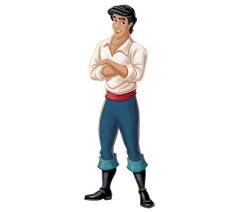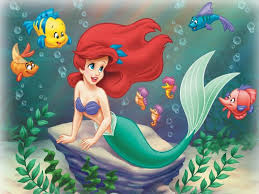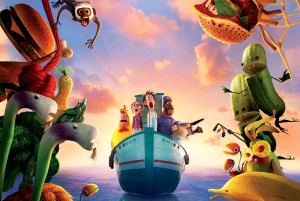Interview: Ron Clements and John Musker of “The Little Mermaid”
Posted on September 30, 2013 at 3:59 pm
After Walt Disney died, the studio he founded faltered, especially Disney animation. Following the powerhouse classics like “Peter Pan,” “Dumbo,” and “The Jungle Book” (the last animated film Walt Disney supervised personally), the animation division became mired in struggles that produced disappointments like “The Black Cauldron.” The documentary Waking Sleeping Beauty tells the story of Walt’s nephew, Roy E. Disney, executives Jeffrey Katzenberg and Michael Eisner, and a new team of animators, writers, and producers brought the studio back for another series of instant classics like “The Lion King” and “Beauty and the Beast.” The movie that was the turning point was this week’s DVD/Blu-Ray Pick of the Week, The Little Mermaid
, one of my very favorites. It was a thrill to speak to the writer/director team of Ron Clements and John Musker about how it all came together.
Tell me how you first started working on this movie, because this was a big transitional moment for Disney animation.
RC: Well, I actually pitched the movie. This was around I think 1985. \I’m bad with dates but this was period of shortly after those kind of a big transition at Disney. Mike Eisner and Roy Disney and Jeffrey Katzenberg came. Roy Disney came back to Disney. He had left for a while. Michael had this thing called “Gong Show.” He’d come over from Paramount Studios. I guess they had that there. It was a way for generating new ideas for animated films or for any films. But in this case, animated films. So he got a group of story people and the directors together in a room. The idea was that everyone was supposed to go out and find five new ideas for animated features. Then, we would meet again in 2 weeks and pitch the ideas. They called it the “Gong Show” because if your idea was not good, it got a gong. So I took that very seriously and I looked for ideas. That same night I went into a bookstore in North Hollywood. I picked up a book of fairy tales, just kind of looking for ideas. I came across The Little Mermaid. I don’t know if I had ever read the story before so I was reading it on the bookstore. As I was reading it, I got really excited because Hans Christian Andersen writes very visually and very cinematically. The images just kind of leap off the page. I thought, “This could really make a great movie. I wonder why they’ve never done this.” Then, as I got through the story I realized maybe part of the reason is that it’s a very, very sad story. It kind of starts sad and then it gets sadder. Then she dies in the end.
So I was thinking about trying to come up with a way to put a little difference in the story so then it would have a little happier ending. I wanted to make the witch more of a villain than she was in the story and turn it into a little bit of more into a fairy tale. So I wrote up a two-page treatment with the basic idea. There’s only one character name in the treatment and that’s Ariel. I called her “Ariel” in the treatment. I’m not sure why but I sort of liked that name. Probably a good name for a mermaid. I also looked for four more ideas because they wanted five ideas. There were other ideas that I came with that I wrote two-page treatments for. But when we reconvened, he said, “Just pitch your best idea.” When they got to me, I said “The Little Mermaid.”
It was gonged.
Partly because Disney had “Splash.” They were working on a sequel to “Splash” which they never actually made. So they gonged it. But I gave them the treatment anyway and the other treatments. A couple days later, I got a call from Jeffrey Katzenberg. He went through the different treatments. Then, he said, “Michael and I looked at this ‘Little Mermaid’ thing and we think it’s really good. We want to do it. We want to put it into development,” which I was very excited about because I was really depressed when it got gonged.
One reason I love this movie is the traditional, hand-drawn animation.
JM: Growing up, I was always a fan of this animation. I drew my stuff. In college, I was a cartoonist at The Daily Northwestern. So I draw myself. I was an animator. But basically, I went to Northwestern to major in English, wound up in college for two years. Studied animation there. Came to Disney. My first week at Disney was the week that “Star Wars” came out. But anyway, I got to learn from Eric Larson, who’s one of the “Nine Old Men.” He was sort of the mentor for the younger animators. Literally, you would take your animation to him and he would take a piece of paper and draw, show you how you could improve the acting and the timing and the phrasing and staging and all that sort of stuff. It was really a craft that was passed on from one to the other. But as a kid, certainly, the Disney animated films seemed more vivid to me than a live action film.
There was something about the caricature element, I think not only are things sort of bigger and broader but you can get to the essence of things. So it really had a very strong appeal. I saw “Sleeping Beauty” when I was like 6 years old at the Mercury Theatre.
Then when I came to Disney I was in the company of these wonderful artists. People like Glen Keane, like Mark Henn, who were brilliant animators who could really bring these things to life. Watching it, it was a magical moment always when you see the first animation come to life, like when I saw the first animation on Ariel or on Sebastian or the Genie when we did Aladdin. It isn’t a drawing anymore. It’s a real character. You started treating them that way. Even the animators get protective with their characters. “My character wouldn’t do that.” “Sebastian wouldn’t do that.” They’re all grounded on recognizable human behavior identified through your reliability.
The medium with which you tell the story has evolved over the years. I love 3D animation. I love hand drawn animation. Certainly, the big compelling emotionally evolving stories, wonderfully done in 3D. I like Brad Bird and John Lasseter. But I still draw myself since I am fond of this kind of magic trick, where you can take all this expressiveness and power of drawing and add the element of performance and time. I do feel like animated films really combine a lot of different of art forms, film-making and writing and drawing and painting, to a certain extent even sculpting. It’s a wonderful medium to work with as a craftsman because it’s such so rich and so varied and so expressive.
One of my all-time favorite Disney villains is Ursula the sea-witch. So tell me about developing that character.
 RC: She was really a fun character to develop. I think John and I had a lot of fun with her. We had met with Howard Ashman fairly early on. We talked about the songs. Mostly, about where they might go. We talked about the witch’s song. Howard always saw the witch as Joan Collins, the “Dynasty” villain. When we wrote the script, we actually were thinking Beatrice Arthur a little bit. Then, when we went to casting, we wanted to try to cast Beatrice Arthur. Actually, I don’t think we ever got past her agent. They were insulted that we were thinking of her as a witch. I don’t think that they liked the idea. Pat Carroll then actually auditioned for the role. She did a great job. She really was just right. So that all worked out really well. Also, the other thing about the character is we developed her. She didn’t start out being part squid or part octopus. Before that, we explored her as part manta ray and part fish. Then we saw a pretty simple drawing, putting Ursula on an octopus body with tentacles. That was like “Yeah, that’s it.” That’s right. We studied octopus footage just to see how they move. There was a very kind of seductive and yet scary aspect. It’s just the sinuous way they move. So it all kind of came together. John and I, we like villains. She was certainly fun to do.
RC: She was really a fun character to develop. I think John and I had a lot of fun with her. We had met with Howard Ashman fairly early on. We talked about the songs. Mostly, about where they might go. We talked about the witch’s song. Howard always saw the witch as Joan Collins, the “Dynasty” villain. When we wrote the script, we actually were thinking Beatrice Arthur a little bit. Then, when we went to casting, we wanted to try to cast Beatrice Arthur. Actually, I don’t think we ever got past her agent. They were insulted that we were thinking of her as a witch. I don’t think that they liked the idea. Pat Carroll then actually auditioned for the role. She did a great job. She really was just right. So that all worked out really well. Also, the other thing about the character is we developed her. She didn’t start out being part squid or part octopus. Before that, we explored her as part manta ray and part fish. Then we saw a pretty simple drawing, putting Ursula on an octopus body with tentacles. That was like “Yeah, that’s it.” That’s right. We studied octopus footage just to see how they move. There was a very kind of seductive and yet scary aspect. It’s just the sinuous way they move. So it all kind of came together. John and I, we like villains. She was certainly fun to do.
And this movie also has one of my favorite Disney princes.
 RC: I’m glad to hear you say that. I mean, because princes are tough. They are always tough. The toughest character to animate. That’s why in Snow White, you only see the prince at the very beginning of the movie and at the end of the movie. They’ve always kept the princes to a minimum. Same with Cinderella. Cinderella has a little better prince. But still, they’re hard to draw. They’re hard to animate. The acting is tough. A realistic girl is hard but guys are harder to do. Girls are more fun to draw. Guys are tough to draw. So it’s got to be a really good animator. Only the best animators really can do the prince. But it’s not the most fun character to animate. We really wanted him to be more of a character, more likeable and to get more of him. Even though, it’s a little bit of a kind of a thankless job. Even for the actors and the animators. It’s like it’s a tough job but somebody’s got to do it.
RC: I’m glad to hear you say that. I mean, because princes are tough. They are always tough. The toughest character to animate. That’s why in Snow White, you only see the prince at the very beginning of the movie and at the end of the movie. They’ve always kept the princes to a minimum. Same with Cinderella. Cinderella has a little better prince. But still, they’re hard to draw. They’re hard to animate. The acting is tough. A realistic girl is hard but guys are harder to do. Girls are more fun to draw. Guys are tough to draw. So it’s got to be a really good animator. Only the best animators really can do the prince. But it’s not the most fun character to animate. We really wanted him to be more of a character, more likeable and to get more of him. Even though, it’s a little bit of a kind of a thankless job. Even for the actors and the animators. It’s like it’s a tough job but somebody’s got to do it.
Tell me a little bit about the challenge of underwater scenes and what that’s like for animators.
RC: When we first proposed it, we knew that it was going to be really, really challenging. I mean, for a lot of reasons. But one of the big reasons is two-thirds of the movie takes place underwater. All that requires a lot of  effects animation. We have two kinds of animation in these animated films. We have character animation, the artists who animate the characters. They’re kind of like actors. We always feel they are actors with a pencil. Glen Keane and Mark Henn did Ariel. That’s what they do. Then, we have effects animators. Effects animators do the non-character stuff that moves which is like water, waves, or bubbles. Or fire or smoke or light effects, anything that moves that isn’t the character. This probably had more character animation than any Disney movie project since “Fantasia.” And it really had a lot of effects, even with the character stuff — like whenever Ariel is underwater, her hair has to move all the time. Hair moving underwater is tricky. We had a lot of meetings about hair. One of the extras in the video is some of the live action footage that we shot for reference to see the hair floating.
effects animation. We have two kinds of animation in these animated films. We have character animation, the artists who animate the characters. They’re kind of like actors. We always feel they are actors with a pencil. Glen Keane and Mark Henn did Ariel. That’s what they do. Then, we have effects animators. Effects animators do the non-character stuff that moves which is like water, waves, or bubbles. Or fire or smoke or light effects, anything that moves that isn’t the character. This probably had more character animation than any Disney movie project since “Fantasia.” And it really had a lot of effects, even with the character stuff — like whenever Ariel is underwater, her hair has to move all the time. Hair moving underwater is tricky. We had a lot of meetings about hair. One of the extras in the video is some of the live action footage that we shot for reference to see the hair floating.
JM: You need people who have to do all the bubbles and all the underwater patterns and all that. We had a budget and the schedule and everything so we really did have to pick our spots. Like “Here’s where the water is got to be, so it’s got to be the A level in this scene. In this other one, the water is not quite as important. This one is quick scene, we can kind of punch this one a little bit. But this one is got to be really the top of the line.”
The crazy thing is even to get the production level we want on the original film, we want some hand inking. They’ve gotten away from hand inking in fact, certainly. So we sent some of the bubbles in the movie actually to mainland China. They were inked in China.
Why does this story have such enduring appeal?
JM: You see at the heart of it, “The Little Mermaid” is the father-daughter story. It’s an overprotective father. There’s a daughter who is kind of adventurous and rebellious and wanting to see a new world. How do they resolve that? That story is still in place today.

